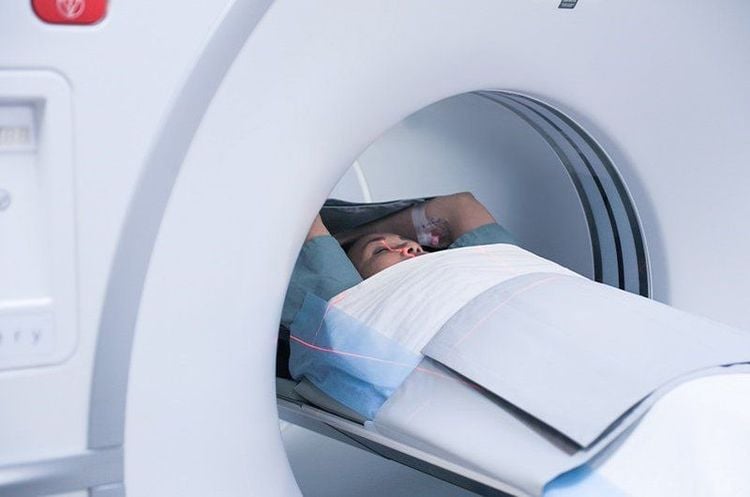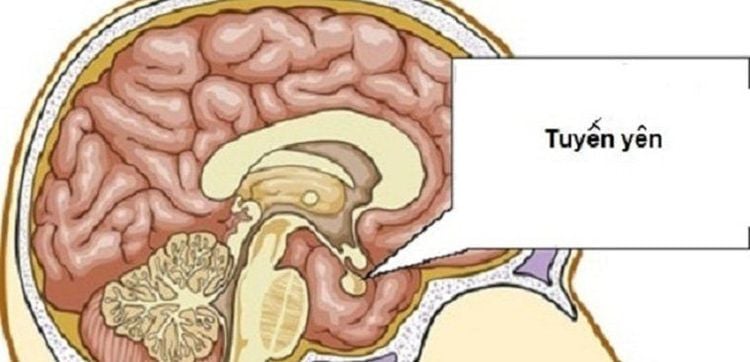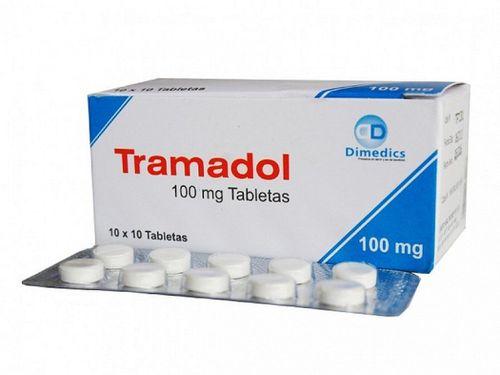This is an automatically translated article.
Patients with pituitary tumor often feel that the tumor presses on nerves, causing characteristic signs such as: Headache, dizziness, nausea, temporal hemiparesis, drooping eyelids... Treatment has many methods, but the most considered option is surgery for pituitary tumors through the sphenoid sinus.
1. Pituitary tumor surgery by way of the sphenoid sinus
Pathological pituitary tumors usually account for about 10% of intracranial tumors. Most pituitary tumors are benign, arising from the anterior pituitary gland (posterior pituitary tumors are also present but are very rare). Based on clinical signs combined with endocrine tests, observing tumor images on magnetic resonance ... doctors will consider suitable treatment methods for patients. The treatment options available are pituitary surgery, radiation therapy, or medical therapy.
Currently, with the development of technology such as Navigator nerve positioning system, endoscopic system, microsurgery microscope, the form of pituitary tumor surgery by sphenoid sinus is more and more widely indicated and brought to the market. positive outcomes for patients.
Indications for surgery for pituitary tumor:
The tumor is located in the pituitary or sphenoid sinus, rarely growing upwards. Hypersecreting and non-secretory pituitary tumors, mixed. In the case of pituitary adenoma undergoing medical treatment, radiotherapy failed. The pituitary tumor progressed below the sphenoid sinus area. The pituitary tumor invades superiorly. Lateral invasion of pituitary gland. Recurrence of pituitary tumor.
2. Surgical procedure for pituitary tumor by way of sphenoid sinus
2.1 Preparation for surgery
Before surgery, the patient will be carefully examined clinically including:
Specialist assessment of eyes, endocrinology, otolaryngology... CT scan, brain magnetic resonance imaging to assess the structure skull base Perform preoperative anesthetic examination as prescribed. After that, the patient is shaved or washed, cleaned and disinfected the surgical area.
Prepare means and instruments used in surgery

Chụp CT cho phép chẩn đoán bệnh
2.2 The surgical procedure for pituitary tumor
At the beginning of surgery, depending on the tumor location, the patient is placed in the maximum supine position, with the head straight or slightly tilted to the left. The patient's head is securely fixed on a dedicated Mayfield frame. The anesthesiologist then administers endotracheal anesthesia.
Steps of surgery for pituitary adenoma by way of the sphenoid sinus:
Stage 1: Expose the sphenoidal opening
Register the nerve positioning system (Neuronavigation) Clean 2 noses with diluted Betadine solution. Apply Naphazoline nasal decongestant to the mucous membranes. Apply local anesthetic to the nasal mucosa if necessary. Widely disinfect the surgical area, anesthetize the skin incision area. Pulling out the lower and middle nasal coils, along the outer surface of the nasal septum, the sinus opening can be identified; If the nasal turbinate is too large, crooked, inflamed, or too narrow, the lower or middle turbinate can be removed. Stage 2: Open the anterior wall of the sphenoid sinus
Make skin incision, separate the nasal mucosa or find the sinus opening, cut the anterior wall with an electric knife on 1 or both sides. This maneuver exposes the anterior wall of the sphenoid sinus. Open the sinus wall with a grinder and trigger pliers, cut the beak anteriorly, and resect the sphenoid septum. Careful resection of the septum sphenoid sinus can cause damage to the internal carotid artery, so the operation should be careful. Then 3: Open the saddle pit floor
The saddle pit floor is opened with a drill, chisel or trigger pliers. There are some cases where the tumor invades the pituitary floor and causes thinning and perforation of the pituitary floor. When opening the anterior wall, removing the sinus mucosa will immediately reveal the tumor located in the sinus and easily expand the floor of the pituitary fossa with trigger pliers. If the tumor shows signs of spreading posteriorly, anteriorly, or bilaterally, expand toward the tumor to control the tumor's circumference. The degree of enlargement of the floor of the pituitary also depends on the location and size of the tumor. Stage 4: Epidural and pituitary tumor resection
Epidural opening with a small knife in an arc or plus sign. Carefully remove the tumor with a curette, pince, or aspiration, avoiding tearing of the arachnoid. (If unfortunately the arachnoid is torn, then the dura mater should be weighed, combined with Bioglue injection) Hemostasis by bipolar electrocautery, Surgicel gauze, Spongel or Floseal glue. Fill the surgical site with fat tissue. Reposition the nasal mucosa or cover the nasal mucosa flap to fill the incision (if necessary). Step 5: Close the incision
Irrigate with dilute Betadine solution and saline serum. Put 2 pieces of Meche merocel gauze on the sides of the nose and fix it. Closing the incision after transsphenoidal pituitary tumor surgery is very important. Plays the role of sealing, avoiding cerebrospinal fluid leakage, infection, hernia.
4. Monitoring and treatment after surgery
Monitoring postoperative signs: After surgery, it is necessary to monitor respiratory signs, pulse, blood pressure, circulation, pituitary hormone in the blood, evaluate electrolyte disturbances, temperature, liver function , kidney ... of the patient to evaluate the results of surgery.
After surgery for pituitary adenoma by sphenoid sinus, some risks can still occur leading to complications. Some common complications after surgery may include:
Bleeding in the brain/nose after surgery: The surgical process may inadvertently affect large arteries or small blood vessels... leading to bleeding. postoperative bleeding. The majority of patients had postoperative bleeding due to damage to the palatine palatine artery, causing infection of the nasal cavity and necrosis. In this case, it is possible to manage according to the bleeding lesion and consider surgical removal of the hematoma if necessary. Ventricular dilation: A condition in which cerebrospinal fluid is blocked and accumulates too much (possibly due to bleeding or hemorrhage). The solution is to drain the ventricles out or into the abdomen. Diabetes insipidus or adrenal insufficiency : The doctor may prescribe medication (hormone replacement), extra water, electrolytes. Cerebrospinal fluid leak: A complication that occurs when cerebrospinal fluid flows from the skull to the outside through the patient's nostrils or ears. For treatment, it is necessary to drain the lumbar cerebrospinal fluid continuously for 4-5 days until the leak is gone, stitches to strengthen the incision. Injury to the internal carotid artery: Treated by surgical compression, using a piece of pulsator muscle taken from the thigh or temporal muscle to stop bleeding. Injury to the cavernous sinuses: Treat by elevating the patient's head, pressing surgically to stop bleeding. Injury to draining vein : Hemostasis with unipolar or bipolar electrocautery. Silver clips can be used to stop bleeding in some cases. Hypopituitarism: It is necessary to treat hypopituitarism by supplementing the depleted hormones.

Sau phẫu thuật, người bệnh có thể gặp phải biến chứng suy tuyến yên
Vinmec International General Hospital with a system of modern facilities, medical equipment and a team of experts and doctors with many years of experience in neurological examination and treatment, patients can completely peace of mind for examination and treatment at the Hospital.
To register for examination and treatment at Vinmec International General Hospital, you can contact Vinmec Health System nationwide, or register online HERE.
SEE MORE
Pituitary tumors: Causes, symptoms, diagnosis and treatment Pituitary tumors: When is hormone replacement therapy needed? Measures to treat pituitary tumors













